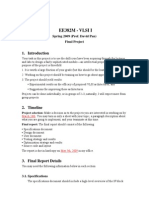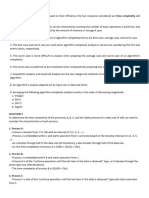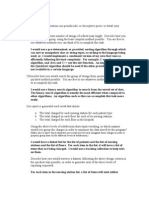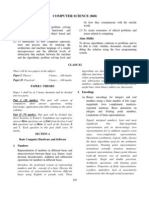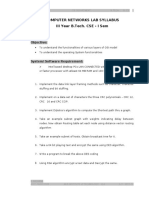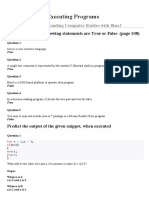(HK1 2425 - CSC14003) Project 1 - Search
(HK1 2425 - CSC14003) Project 1 - Search
Uploaded by
Khang TrầnCopyright:
Available Formats
(HK1 2425 - CSC14003) Project 1 - Search
(HK1 2425 - CSC14003) Project 1 - Search
Uploaded by
Khang TrầnOriginal Title
Copyright
Available Formats
Share this document
Did you find this document useful?
Is this content inappropriate?
Copyright:
Available Formats
(HK1 2425 - CSC14003) Project 1 - Search
(HK1 2425 - CSC14003) Project 1 - Search
Uploaded by
Khang TrầnCopyright:
Available Formats
Project 1.
Search Introduction to Artificial Intelligence CS14003
Project 1. Search
Ares’s adventure
1 Introduction
According to legend, hidden deep in a faraway kingdom is a gate that leads to mysterious treasure.
It’s said that to open the gate, one must solve a maze by moving heavy stones onto secret switches.
Though this may sound simple, many have tried and failed, as the maze is very tricky, and moving
the large stones through tight spaces is tough. Even a small mistake could trap the challenger in
the maze forever.
One day, a young adventurer named Ares decided to face this challenge. He knew that success
would need careful planning, paying attention to every move, every details, and never giving up.
Your task is to help Ares on his adventure. Using the search algorithms you have learned in the
Introduction to Artificial Intelligence course, you must guide him through the challenging maze,
finding the path and positioning the stones on the switches to unlock the treasure gate.
Figure 1: Example of a maze modeled in the 2D world.
Do you have the skills to help Ares conquer the maze and uncover the legendary treasure?
Begin the journey and show your intelligence!
University of Science Faculty of Information Technology Page 1
Project 1. Search Introduction to Artificial Intelligence CS14003
2 Description
The maze is depicted as a grid of size n × m, where each cell represents either a free space, a wall,
a stone, or a switch. Ares (represented as an agent) can move one square at a time in 4 directions:
Up, Down, Left, and Right. He cannot pass through walls or stones.
If there’s a stone in the next space and the space beyond is free, he can push the stone there.
He cannot pull stones, and stones cannot be pushed into walls or other stones.
Figure 2: Ares pushing stones: (a) Valid move, (b) and (c) Invalid moves.
Each stone has a different weight, which means Ares must consider the most efficient way
to push the stones onto switches. Pushing heavier stones take more effort and limit his movement.
This introduces the need for an optimal strategy when deciding which stones to push and where.
The movement cost of Ares is calculated as follows:
• Each step Ares takes without pushing a stone incurs a base cost of 1.
• Pushing a stone increases the move’s cost according to the stone’s weight.
The objective is to push all stones onto the switches. Every switch can be activated by
any stone of any weight, and the number of stones always equals the number of switches.
Students are required to implement these following search algorithms:
• Breadth-First Search (BFS).
• Depth-First Search (DFS).
• Uniform Cost Search (UCS).
• A* Search with heuristic.
University of Science Faculty of Information Technology Page 2
Project 1. Search Introduction to Artificial Intelligence CS14003
3 Requirements
3.1 Input
Students are required to design at least 10 different input files, named according to the structure
input-01.txt, input-02.txt, ..., input-10.txt. Each input should have different parameters
such as the number of stones on the maze, the weight of each stone, or the structure of the maze.
The format of the input file is as described below:
• The first line contains list of integers representing the weights of each stone, in the order
they appear in the grid, from left to right and top to bottom.
• The following lines describe the grid itself using the following characters:
– “#” for walls.
– “ ” (whitespace) for free spaces.
– “$” for stones.
– “@” for Ares.
– “.” for switch places.
– “*” for stones placed on switches.
– “+” for Ares on a switch.
For example:
Figure 3: Example of a maze layout (left) and its corresponding input file (right).
University of Science Faculty of Information Technology Page 3
Project 1. Search Introduction to Artificial Intelligence CS14003
3.2 Output
The output must be both visualized using a Graphical User Interface (GUI) to display the process
and saved as an output file. Below are the detailed output requirements:
• Output file:
The output files should be named following the format output-01.txt, output-02.txt, etc.
The content of each output file must include the following information:
– The first line specifies the name of the algorithm used.
– The second line provides detailed statistics, including:
∗ The number of steps Ares must take,
∗ The total weight he has to push,
∗ The number of nodes generated by the algorithm,
∗ The time taken to complete the search, and
∗ The memory consumed during the process.
– The third line presents the solution as a string representing Ares’s sequence of actions.
Lowercase letters uldr are used for movement, while uppercase letters ULDR represent
pushing actions.
For example:
BFS
Steps: 16, Weight: 695, Node: 4321, Time (ms): 58.12, Memory (MB): 12.56
uLulDrrRRRRRRurD
DFS
...
• Graphical User Interface (GUI):
– The GUI must provide a visual representation all elements on the maze.
– The GUI must animate step-by-step the process of Ares moving through the maze and
pushing stones according to the solution sequence generated by the algorithm.
– Display statistics during, including the step count and the weight being pushed.
– A button should be provided to start or pause the animation, as well as a reset option
to restart the process. And a button to choose which algorithms for visualization.
University of Science Faculty of Information Technology Page 4
Project 1. Search Introduction to Artificial Intelligence CS14003
3.3 Programming language
The source code must be written in Python. You are allowed to use any supporting libraries;
however, the main algorithms directly related to the search process must be implemented by you.
3.4 Report
• Member information (Student ID, full name, etc.)
• Work assignment table, which includes information on each task assigned to team members,
along with the completion rate of each member compared to the assigned tasks.
• Self-evaluation of the project requirements.
• Detailed explanation of each algorithm (implementation process, heuristic function, etc.).
Illustrative images and diagram are encouraged.
• Description of the test cases and experiment results (memory usage, time complexity, etc.)
Highlight challenges and compare overall behavior of your algorithms.
• The report needs to be well-formatted and exported to PDF. If there are figures cut off by
the page break, etc., points will be deducted.
• References (if any).
3.5 Demonstration videos
• Demo videos (recording the running process of your program for some test case) should be
uploaded to YouTube or Google Drive, and the public URLs are included in the report.
• In the video, students should start from compiling or running their code, then walk through
the key steps of the program’s execution to make it easy to follow.
3.6 Submission
• Your report, source code and test cases must be contributed in the form of a compressed file
(.zip, .rar, .7z) and named according to the format StudentID1 StudentID2 ...
• If the compressed file is larger than 25MB, prioritize compressing the report and source code.
Test cases may be uploaded to the Google Drive and shared via a link.
University of Science Faculty of Information Technology Page 5
Project 1. Search Introduction to Artificial Intelligence CS14003
Details of the directory organization:
StudentID1 StudentID2 ...
Source
main.py
input-01.txt
input-02.txt
output-01.txt
output-02.txt
requirements.txt (libraries to install)
README.txt (how to run source code)
...
Report.pdf (included video URLs)
4 Assessment
No. Details Score
1 Implement BFS correctly. 10%
2 Implement DFS correctly. 10%
3 Implement UCS correctly. 10%
4 Implement A* correctly. 10%
5 Generate at least 10 test cases for each level with different attributes. 10%
6 Result (output file and GUI). 15%
7 Videos to demonstrate all algorithms for some test case. 10%
8 Report your algorithm, experiment with some reflection or comments. 25%
Total 100%
5 Notices
Please pay attention to the following notices:
• This is a GROUP assignment. Each group has 4 members.
• Duration: about 3 weeks.
• Any plagiarism, any tricks, or any lie will have a 0 point for the course grade.
University of Science Faculty of Information Technology Page 6
You might also like
- 01 OS9051-C-1800 Introduction To NetActDocument89 pages01 OS9051-C-1800 Introduction To NetActBoris100% (1)
- Engine Control SystemDocument21 pagesEngine Control SystemRaúl MartínezNo ratings yet
- Abstract Data TypesAssignment 2Document1 pageAbstract Data TypesAssignment 2junaid123xtNo ratings yet
- Week 2 Project - Search Algorithms - CSMMDocument8 pagesWeek 2 Project - Search Algorithms - CSMMRaj kumar manepallyNo ratings yet
- Laboratorio 1Document12 pagesLaboratorio 1Daniel Israel Hidalgo RuedaNo ratings yet
- (Spring 2020) ASSIGNMENT-2 (Uninformed and Informed Search) 50Document7 pages(Spring 2020) ASSIGNMENT-2 (Uninformed and Informed Search) 50Mian Qasim MahmoodNo ratings yet
- ML Lab ExperimentsDocument116 pagesML Lab ExperimentsSaniyaNo ratings yet
- Operating Systems Lab (r18)Document78 pagesOperating Systems Lab (r18)kvengatesh2005No ratings yet
- Algorithms and Data StructuresDocument11 pagesAlgorithms and Data StructuresMark Devlin DungoNo ratings yet
- Pdclab 6Document15 pagesPdclab 6210316No ratings yet
- 01 Overview of Data Structure PDFDocument20 pages01 Overview of Data Structure PDFKyle DandoyNo ratings yet
- Dsa Manual FinalDocument65 pagesDsa Manual FinalK. Malathi Staff,COMPUTER SCIENCE AND ENGINEERINGNo ratings yet
- 1 APT Portfolio Interview Experience - Set 1 (On-Campus) 2Document6 pages1 APT Portfolio Interview Experience - Set 1 (On-Campus) 2Ajay KumarNo ratings yet
- 2410 CCP6214 Assignment (Dynamic)Document8 pages2410 CCP6214 Assignment (Dynamic)Marwah Al-HelaliNo ratings yet
- COMPUTER NETWORKS LAB Manual L On 5.7.14 (STUDENT Copy)Document45 pagesCOMPUTER NETWORKS LAB Manual L On 5.7.14 (STUDENT Copy)Ramu KuchipudiNo ratings yet
- Lecture 2.1.1Document15 pagesLecture 2.1.1deadlygamer6996No ratings yet
- Aamir - DSA AssignmentDocument13 pagesAamir - DSA Assignmentaamirneyazi92No ratings yet
- DPDocument10 pagesDPlearnpolticsNo ratings yet
- CSC 207Document59 pagesCSC 207adandongolambertdanielNo ratings yet
- CSCE 221 Cover Page Programming Assignment #3Document3 pagesCSCE 221 Cover Page Programming Assignment #3Nick InkerNo ratings yet
- Intro To DS and Algo AnalysisDocument51 pagesIntro To DS and Algo Analysissachinkumardbg766No ratings yet
- MidTerm AI PDFDocument4 pagesMidTerm AI PDFTalha Mansoor100% (1)
- Project Deep LearningDocument4 pagesProject Deep LearningPrasu MuthyalapatiNo ratings yet
- Design and Analysis of AlgorithmDocument24 pagesDesign and Analysis of AlgorithmNakuulNo ratings yet
- Data Structures and Algorithms (Using C++)Document112 pagesData Structures and Algorithms (Using C++)ellen deusNo ratings yet
- Ee382M - Vlsi I: Spring 2009 (Prof. David Pan) Final ProjectDocument13 pagesEe382M - Vlsi I: Spring 2009 (Prof. David Pan) Final ProjectsepritaharaNo ratings yet
- DS Practical SyllabusDocument1 pageDS Practical SyllabusManas ParabNo ratings yet
- ITECOMPSYSL Activity 3 - String ManipulationDocument7 pagesITECOMPSYSL Activity 3 - String ManipulationKimCanillasVincere100% (2)
- Define The ProblemDocument10 pagesDefine The ProblemmohammedelshafieNo ratings yet
- DSA Self Placed: GeeksforgeeksDocument20 pagesDSA Self Placed: GeeksforgeeksMohd AmirNo ratings yet
- Big o Solutions To Past Questions 1Document6 pagesBig o Solutions To Past Questions 1martinsakpala2No ratings yet
- Real Time Systems Lab: Handling Shared ResourcesDocument14 pagesReal Time Systems Lab: Handling Shared ResourcesJ robertsNo ratings yet
- On Deep Machine Learning & Time Series Models: A Case Study With The Use of KerasDocument34 pagesOn Deep Machine Learning & Time Series Models: A Case Study With The Use of KerasJorgeMoisesNo ratings yet
- 2021 S2 FOP AssignmentDocument4 pages2021 S2 FOP AssignmentDileeka DiyabalanageNo ratings yet
- 1 Lab + HWK 0 - Mini-Project Selection 2 Project Selection - EPFLDocument4 pages1 Lab + HWK 0 - Mini-Project Selection 2 Project Selection - EPFLKhoa NguyenNo ratings yet
- 1 L1 - Introduction To Data Structure and AlgorithmsDocument96 pages1 L1 - Introduction To Data Structure and AlgorithmsVidit Kumar100% (1)
- AI Lab Course Handout Spring 2024Document10 pagesAI Lab Course Handout Spring 2024Rudroprasad Bandyopadhyay 2No ratings yet
- LAB01Document4 pagesLAB01Bekhedda AsmaNo ratings yet
- Turing Data Engineering ChallengeDocument4 pagesTuring Data Engineering ChallengeOsama RasheedNo ratings yet
- Mca1002 - Problem Solving Using Data Structures and Algorithms - LTP - 1.0 - 1 - Mca1002Document4 pagesMca1002 - Problem Solving Using Data Structures and Algorithms - LTP - 1.0 - 1 - Mca1002Prateek BalchandaniNo ratings yet
- Al Leadex Csc Harmonised Test 8Document6 pagesAl Leadex Csc Harmonised Test 8Nfor LucyNo ratings yet
- Study Material On Data Structure and AlgorithmsDocument43 pagesStudy Material On Data Structure and AlgorithmsGod is every whereNo ratings yet
- CSE 5311: Design and Analysis of Algorithms Programming Project TopicsDocument3 pagesCSE 5311: Design and Analysis of Algorithms Programming Project TopicsFgvNo ratings yet
- VanshDocument17 pagesVanshPiyush SinghNo ratings yet
- Heba DSBook 2022Document337 pagesHeba DSBook 2022Ahmed FawzyNo ratings yet
- Computer Networks Lab Syllabus III Year B.Tech. CSE - I SemDocument87 pagesComputer Networks Lab Syllabus III Year B.Tech. CSE - I SemAnonymous JwoypMYNo ratings yet
- Computer Networks Lab Manual LatestDocument44 pagesComputer Networks Lab Manual LatestSandeep KumarNo ratings yet
- SYLLABUSDocument7 pagesSYLLABUSwtfNo ratings yet
- Data Structures and AlgorithmsDocument6 pagesData Structures and Algorithmssuryaniraj79No ratings yet
- Pre COBOL TestDocument5 pagesPre COBOL TestjsmaniNo ratings yet
- Ee271 08 Lect7 VerificationDocument71 pagesEe271 08 Lect7 VerificationMohammed YounusNo ratings yet
- ISC Computer Science - 2015Document17 pagesISC Computer Science - 2015Bimal Roy MehtaNo ratings yet
- Jbrec CN Lab ManualDocument52 pagesJbrec CN Lab ManualsantoshkumargangaNo ratings yet
- Nhóm AI Đề Tài AnomalyDocument13 pagesNhóm AI Đề Tài Anomalynormalization normalizationNo ratings yet
- AI MidsDocument22 pagesAI MidsTalha MansoorNo ratings yet
- Space Complexity 2Document24 pagesSpace Complexity 2IsanNo ratings yet
- Computer Networks Lab Manual Latest PDFDocument44 pagesComputer Networks Lab Manual Latest PDFKishore SmartNo ratings yet
- Computer Networks Lab Manual LatestDocument44 pagesComputer Networks Lab Manual LatestKande Archana K75% (32)
- Assignment-1 Course Code:CAP205: Date: 08/09/10Document9 pagesAssignment-1 Course Code:CAP205: Date: 08/09/10Manish KinwarNo ratings yet
- Week3 StatDocument4 pagesWeek3 Statsureshroyals02No ratings yet
- Belatrix InfoDocument37 pagesBelatrix InfoBryan RiveraNo ratings yet
- MDS™ Master Station CONFIGURATION SYSTEME 1-2Document17 pagesMDS™ Master Station CONFIGURATION SYSTEME 1-2Janssen N'GadiNo ratings yet
- Amazon ECR: User Guide API Version 2015-09-21Document132 pagesAmazon ECR: User Guide API Version 2015-09-21BetmanNo ratings yet
- FF180 Sem-5Document5 pagesFF180 Sem-510POTE SANKETNo ratings yet
- Digital Control of A Stepper Motor: Instructor's PortionDocument13 pagesDigital Control of A Stepper Motor: Instructor's PortionEngr Nayyer Nayyab MalikNo ratings yet
- Athik Mohamed: EducationDocument1 pageAthik Mohamed: Educationdummy.athikNo ratings yet
- The Fundamental Concepts Behind Deep LearningDocument22 pagesThe Fundamental Concepts Behind Deep LearningAbu RayhanNo ratings yet
- EPM 1173 - Day - 8-Unit - 7-MSP SchedulingDocument17 pagesEPM 1173 - Day - 8-Unit - 7-MSP SchedulingRahul ChawlaNo ratings yet
- Chapter 4 Unit 3 Compiling and Executing Programs WebDocument22 pagesChapter 4 Unit 3 Compiling and Executing Programs WebBeastNo ratings yet
- Error Detection Methods: by DR C Navaneethan / SiteDocument30 pagesError Detection Methods: by DR C Navaneethan / SiteUMA MAHESWARI G 20BIT0317No ratings yet
- SAP ABAP Interview QuestionsDocument28 pagesSAP ABAP Interview Questionsamar_india29No ratings yet
- JD Experimented Embedded Software Engineer For Univers2020Document5 pagesJD Experimented Embedded Software Engineer For Univers2020yoni zerbibNo ratings yet
- Microsurvey Star Net 9: Features and BenefitsDocument8 pagesMicrosurvey Star Net 9: Features and BenefitsAndenet AshagrieNo ratings yet
- Create Bus GuideDocument2 pagesCreate Bus GuidesagarNo ratings yet
- Meaning of Data, Information and Knowledge: For Data in Computer Science, See - For Other Uses, SeeDocument4 pagesMeaning of Data, Information and Knowledge: For Data in Computer Science, See - For Other Uses, SeeLeila MoralesNo ratings yet
- Cloud Computing NotesDocument62 pagesCloud Computing NotesChiaaNo ratings yet
- Review CSI104Document6 pagesReview CSI104Doan Tran Quang Huy (K18 DN)No ratings yet
- M I L-ReviewerDocument12 pagesM I L-ReviewerCindy FloresNo ratings yet
- PCI Express BasicsDocument34 pagesPCI Express BasicsRamakrishnaRao SoogooriNo ratings yet
- Optiplex 7000 Towers Spec SheetDocument10 pagesOptiplex 7000 Towers Spec Sheetcome2pratikNo ratings yet
- Resume Final 108Document2 pagesResume Final 108militantmaverickNo ratings yet
- 2 How To - Tests of Copy Configuration From Client 000 - Note 2838358 - Part2Document7 pages2 How To - Tests of Copy Configuration From Client 000 - Note 2838358 - Part2Helbert GarofoloNo ratings yet
- Designing Domestic Airports: Daet Domestic Airport ComplexDocument4 pagesDesigning Domestic Airports: Daet Domestic Airport ComplexGeo AlediaNo ratings yet
- Northlink: Course SyllabusDocument3 pagesNorthlink: Course SyllabusFlor CabillarNo ratings yet
- 2a-MarqueeSelection ExerciseDocument2 pages2a-MarqueeSelection ExerciseHeman Lee100% (1)
- SAP GRC Access Control Emergency Access Management: April 2016Document26 pagesSAP GRC Access Control Emergency Access Management: April 2016OBULA100% (2)
- Contract Testing With Pact - IoDocument21 pagesContract Testing With Pact - IoshicabuumNo ratings yet
- Mod Menu Crash 2024 01 04-01 29 47Document1 pageMod Menu Crash 2024 01 04-01 29 47geovanabeatriz108No ratings yet

























